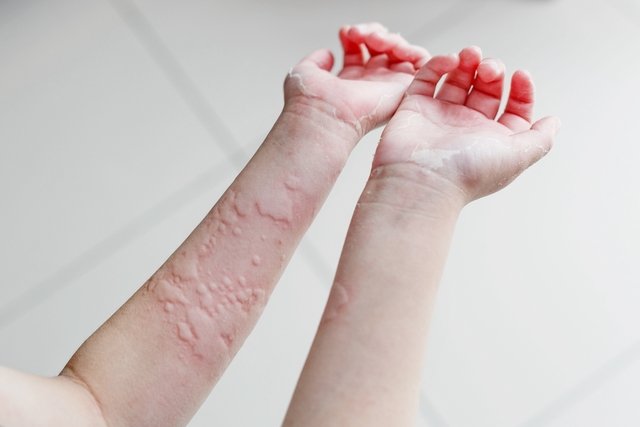Urticaria is a skin irritation that causes symptoms such as red spots, intense itching, welts or swelling on the skin, which can appear in any region of the body, which normally last up to 24 hours, or can last for 6 weeks or more.
Hives can be caused by allergies to insect bites, plants, medicines or foods, but can also occur due to temperature variations, infections or diseases, such as lupus, for example.
Urticaria is treated by a dermatologist, allergist or general practitioner, who may recommend the use of anti-allergy medications, immunosuppressants or biological therapy, depending on the cause of the urticaria.

Urticaria symptoms
The main symptoms of urticaria are:
- Red spots of various sizes on the skin;
- Pink or reddish plaques on the skin;
- Red welts;
- Swelling of the skin;
- Intense itching.
These symptoms can be localized to a specific region of the skin or spread throughout the body and generally last up to 24 hours, disappearing without leaving marks or scars.
However, the spots can appear again on other parts of the body, remaining for around 6 weeks, this type of hives being called chronic urticaria.
Read too: Chronic urticaria: what it is, symptoms, causes and treatment
In cases of a severe allergic reaction or anaphylaxis, symptoms may appear, such as swelling of the lips, tongue, throat or eyes, difficulty breathing, dizziness or fainting. In these cases, you should seek emergency help immediately. See other symptoms of a serious allergic reaction.
How to confirm the diagnosis
The diagnosis of urticaria is made by a dermatologist, allergist or general practitioner through the evaluation of symptoms, health history, recent use of medication or contact with allergenic substances, in addition to a physical examination of the skin.
Make an appointment with a dermatologist in the nearest region:
Taking care of your health has never been easier!
In addition, the doctor must order blood tests and an allergy test, which is carried out in the doctor’s office by applying different substances to the skin, to check for symptoms. See how the allergy test is done.
Possible causes
The main causes of hives are:
- Insect bites;
- Allergy to clothing fabric, pollen, latex or sweat;
- Foods such as peanuts, egg, seafood
- Food dyes or preservatives;
- Excessive stress;
- Extreme heat or cold;
- Infections, such as mononucleosis;
- Medicines;
- Cleaning products, toxic products or toxic plants;
- Diseases, such as lupus or leukemia.
It is not always possible to find out the cause of hives, however, the doctor’s diagnostic tests and health history can help understand the cause, type of hives and thus indicate the most appropriate treatment.
Types of hives
The main types of urticaria are:
1. Acute urticaria
Acute urticaria is caused by contact with an allergenic substance that causes the release of histamine in the body, responsible for the symptoms, which can last up to 24 to 72 hours or less than 6 weeks to disappear.
2. Chronic urticaria
Chronic urticaria is characterized by symptoms lasting 6 weeks or more and may reappear over months or years.
3. Emotional or nervous urticaria
Emotional or nervous urticaria is related to emotional factors, such as excess stress or anxiety and, therefore, the symptoms are more intense during periods of greater tension. Find out more about this type of hives.
4. Cholinergic urticaria
Cholinergic urticaria appears after an increase in body temperature, due to hot baths, eating hot food or physical exercise, for example, and symptoms last for around 90 minutes.
5. Gestational urticaria
Gestational urticaria can be caused by stress, food allergies, insect bites or medications, or due to sensitivity to changes in hormone levels during pregnancy, such as prolactin and progesterone, for example.
Read too: Gestational urticaria: what it is, symptoms, causes and treatment
6. Urticaria pigmentosa
Urticaria pigmentosa, also called systemic mastocytosis, is caused by an excess of immune system cells in the skin, known as mast cells, and is more common in babies and children.
7. Contact urticaria
Contact urticaria can appear after contact with allergenic substances, such as latex or resin, for example.
8. Solar urticaria
Solar urticaria is one of the least common types of urticaria, caused by exposure to the sun, which leads to an exaggerated reaction of the immune system to the sun’s rays, causing an inflammatory response in the regions most exposed to the sun, such as arms, hands, neck, chest and face.
9. Urticaria vasculitis
Vasculitis urticaria is a rarer type of urticaria that causes inflammation of the veins, which can cause symptoms such as pain or burning in the affected area.
How the treatment is carried out
Urticaria treatment must be carried out under the guidance of a dermatologist, allergist or general practitioner, and generally involves the use of medicines to alleviate symptoms.
The main remedies that may be recommended by your doctor for the treatment of urticaria are:
- Antihistaminessuch as fexofenadine, loratadine, diphenhydramine or cetirizine;
- Corticosteroid ointmentssuch as hydrocortisone or dexamethasone;
- Corticosteroids in tablet formsuch as prednisone or prednisolone;
- Biological therapysuch as omalizumab;
- Immunosuppressantssuch as cyclosporine or tacrolimus
These remedies should always be prescribed by a doctor, according to the severity of the symptoms and causes of urticaria. Check out all the remedies recommended for urticaria.
In the most serious cases of anaphylaxis, treatment is carried out in the hospital, with the application of adrenaline to the muscle, antihistamines or injectable corticosteroids, in addition to clearing the airways. See how anaphylaxis is treated.

Sign up for our newsletter and stay up to date with exclusive news
that can transform your routine!
Warning: Undefined array key "title" in /home/storelat/public_html/wp-content/plugins/link-whisper-premium/templates/frontend/related-posts.php on line 12
Warning: Undefined array key "title_tag" in /home/storelat/public_html/wp-content/plugins/link-whisper-premium/templates/frontend/related-posts.php on line 13



